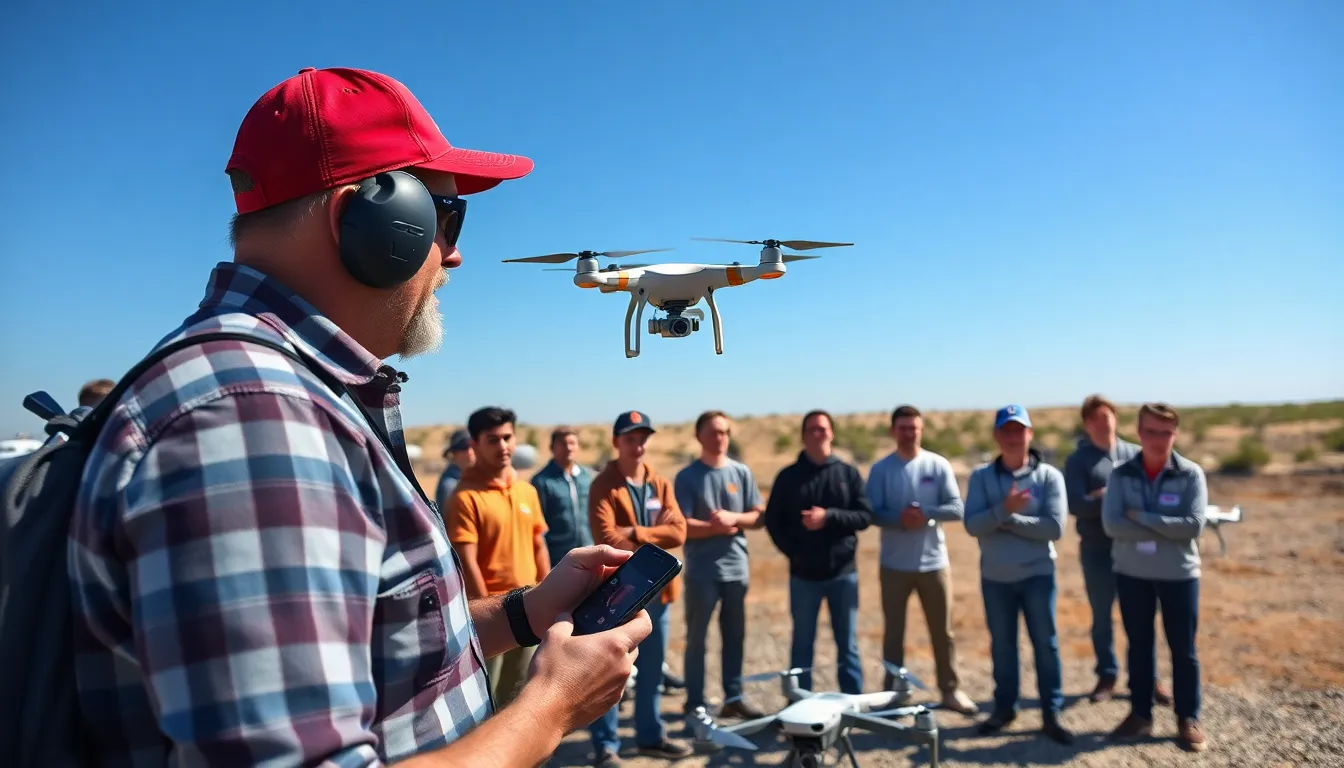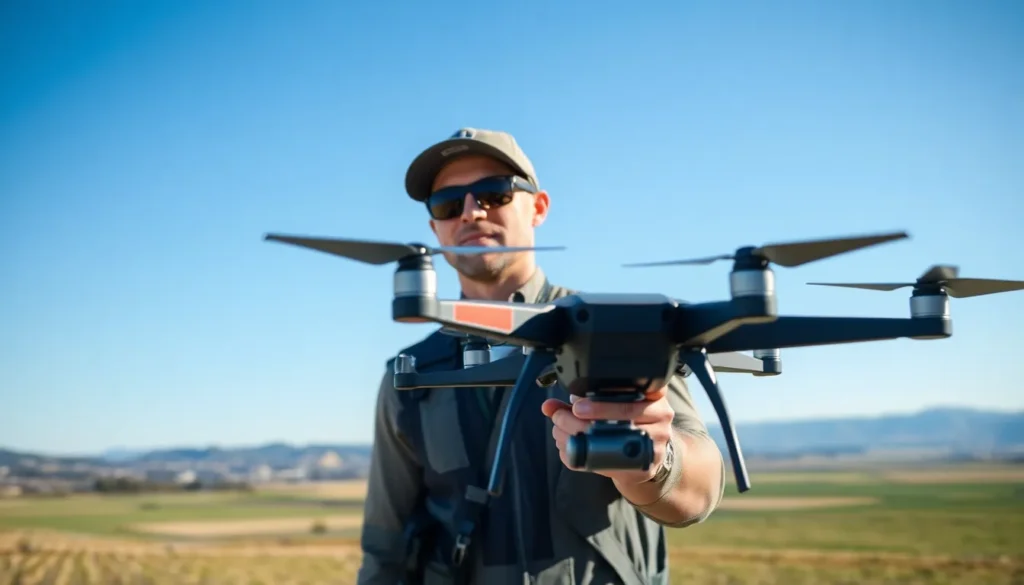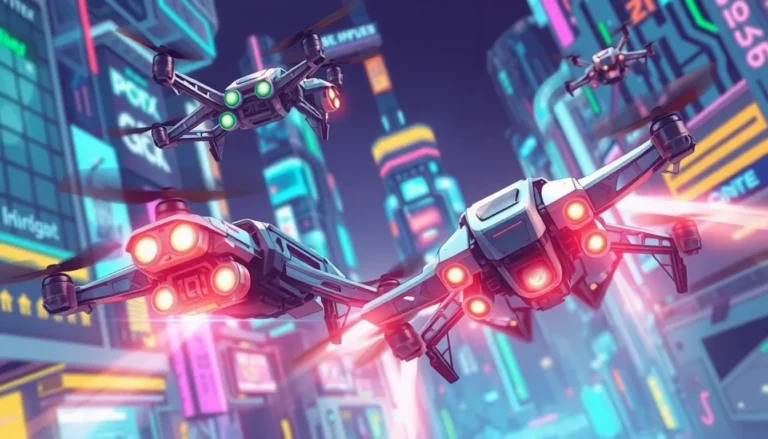Table of Contents
ToggleIn a world where drones are the new superheroes of the sky, mastering the art of flight has never been more crucial. Whether it’s capturing stunning aerial shots for Instagram or surveying vast landscapes, drone flight training equips aspiring pilots with the skills they need to soar. Who wouldn’t want to impress friends with a drone that dances through the air like a pro?
Overview of Drone Flight Training
Drone flight training plays a crucial role in the effective use of drones for various applications. Prospective pilots acquire necessary skills and knowledge to operate drones safely and efficiently.
Importance of Drone Flight Training
Drone flight training builds essential skills for operators to handle drones confidently. Gaining knowledge of regulations ensures compliance with local and federal laws. Training enhances safety awareness, reducing the risk of accidents during flights. Familiarity with different drone models promotes adaptability in various scenarios. Operative proficiency not only supports personal growth but also opens up professional opportunities in industries like photography, agriculture, and surveying.
Types of Drone Flight Training Programs
Several types of drone flight training programs cater to different skill levels and interests. Beginner programs introduce basic piloting techniques and regulations for novice operators. Intermediate courses focus on advanced maneuvers and essential maintenance knowledge. Specialized training provides expertise in areas such as aerial photography, search and rescue, or agricultural monitoring. Online courses offer flexibility, allowing individuals to learn at their convenience. In-person training sessions often include hands-on experience, which is beneficial for practical applications.
Features of Effective Training Courses

Effective drone flight training courses encompass various features that enhance learning and skill development. These elements ensure participants gain the necessary knowledge and experience for successful drone operation.
Instructional Methods
Diverse instructional methods play a critical role in effective training. Courses should include interactive lectures, hands-on demonstrations, and real-time simulations. Engaging techniques help participants retain information better. Instructors must tailor their teaching strategies to accommodate varied learning preferences. Providing access to video tutorials and supplementary materials enhances the overall experience. Frequent assessments ensure participants grasp the material and can apply it in practice.
Practical Flight Experience
Practical flight experience forms the backbone of drone training. Hands-on practice builds confidence and reinforces theoretical concepts learned in the classroom. Effective courses offer ample flight time under the supervision of qualified instructors. Participants often fly different drone models, addressing the nuances in operation. Measuring progress allows instructors to provide feedback, helping students refine their skills. Incorporating real-world scenarios prepares participants for actual flying conditions, ensuring they’re ready for any situation.
Certification and Regulations
Drone flight training necessitates understanding certification and regulations. Compliance with aviation standards ensures safe operation in controlled airspace.
Understanding Drone Pilot Licenses
Pilots must obtain licenses to fly drones legally. The Federal Aviation Administration (FAA) issues the Remote Pilot Certificate, a requirement for commercial drone operations. To qualify, applicants must pass a knowledge test covering regulations, airspace classification, and weather. Some exceptions apply for public safety and educational institutions, allowing specific operations without a certificate. Completing a reputable training program enhances knowledge and improves test performance.
Regulatory Bodies and Their Role
Regulatory bodies oversee drone operation standards and safety protocols. In the United States, the FAA plays a pivotal role in establishing rules for drone use. They provide guidelines on pilot certification, operational limitations, and airspace restrictions. Local governments also enforce regulations, which may vary by region. Understanding these regulations ensures compliance and supports responsible drone usage.
Challenges in Drone Flight Training
Drone flight training presents various challenges that aspiring pilots encounter. Understanding these obstacles is vital for successful mastery.
Common Obstacles for New Pilots
New pilots often face issues such as lack of experience and unfamiliarity with drone controls. Confusion about regulations can create further complications during training. Weather conditions frequently disrupt practice sessions, hindering skill development. Many beginners also struggle with maintaining focus and managing distractions, especially in busy environments. Technical malfunctions can lead to frustration and time losses. Additionally, insufficient guidance or support from instructors diminishes confidence and hinders progress.
Solutions and Best Practices
Adopting a structured training schedule significantly enhances learning. Regular practice in diverse environments helps build competence. Utilizing simulators to develop flight techniques allows pilots to hone skills without risk. Seeking mentorship or feedback from experienced pilots fosters growth and builds confidence. Staying updated on regulations through resources from the FAA ensures compliance and knowledge. Emphasizing patience and gradual progression shapes a more effective learning experience. Consistent evaluation and reflection on performance aid in identifying areas for improvement.
Benefits of Professional Training
Professional training in drone flight offers numerous advantages that aspiring pilots can benefit from significantly.
Enhanced Safety and Compliance
Safety ranks as a top priority in drone operations. Through professional training, participants learn essential safety protocols and regulations, which foster a culture of responsible flying. Adhering to rules set by the Federal Aviation Administration (FAA) becomes easier with thorough training. Pilots develop skills that minimize risks associated with flying in crowded or restricted airspaces. Understanding weather conditions and technical operations ensures safer drone flights. Training covers the importance of pre-flight checks and emergency procedures, reinforcing safe practices. By completing a structured course, pilots emerge more prepared for potential challenges, enhancing overall safety.
Career Opportunities in the Drone Industry
Engaging in professional drone flight training opens doors to various career paths. Industries such as photography, agriculture, and surveying increasingly seek skilled drone operators. Pilots with credentials boost their employability and can pursue roles in aerial surveying, inspection services, and film production. The demand for drone services continues to rise, offering promising job prospects. Specialized training helps individuals differentiate themselves in a competitive job market. Moreover, expertise gained through training leads to potential freelance opportunities, allowing for flexibility and independence. As technology evolves, professionals in the drone industry can explore diverse applications, from real estate to environmental monitoring, expanding their career horizons.
Drone flight training is essential for anyone looking to excel in this rapidly growing field. With the right training, aspiring pilots can develop the skills necessary for safe and efficient drone operation while navigating complex regulations.
The diverse training programs available cater to various needs, whether through hands-on experience or flexible online courses. As industries increasingly rely on drone technology, the demand for qualified pilots continues to rise, presenting numerous career opportunities.
By investing in professional training, individuals not only enhance their flying abilities but also contribute to a culture of safety and responsibility in drone operations. Embracing this journey can lead to exciting prospects in a dynamic and evolving industry.







